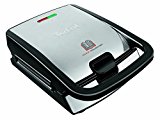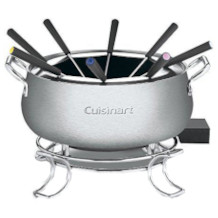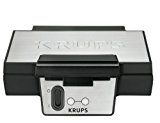Ice cream maker purchasing advice: how to choose the right product
- What you need to know
- You can make fresh ice cream in all imaginable flavors at home with an ice cream maker.
- Machines with a compressor are quick but expensive. You can buy ice cream makers with a rechargeable battery at a lower price, but they need to be pre-cooled.
- Making ice cream usually takes between 20 and 40 minutes. For machines without a compressor, you also have to allow 8 to 24 hours for pre-cooling beforehand.
- Most machines have a capacity of between 0.5 and 2 quarts (0.5-2L).
- As far as the motor is concerned, the stronger the stirring power, the creamier the ice cream. Most motors have a power output between 100 and 300 watts.
- Features like automatic shut-off, timers and keep-cool are useful additions.
An ice cream parlor in your own home
As soon as the temperatures rise, long queues form in front of ice cream parlors. After all, there is nothing more refreshing than a delicious ice cream, especially in summer. If you don’t feel like waiting, you’ll often have to settle for industrially produced ice cream from the supermarket. However, what you get from the store can’t really compete with freshly prepared gelato.
This is where an ice cream maker comes in. With it, you can conjure up your own ice cream creations in your kitchen whenever you want. Homemade ice cream is a huge hit at children’s birthday parties, barbecues, and other events. And when all the ice cream parlors are closed in the cold months, you can still indulge your cravings. In fact, you might even want to experiment with wintery flavors like plum and cinnamon.
What are the advantages of an ice cream maker?
Still not sure whether the investment is worth it for you? If you have your own ice cream maker, you can choose exactly what to put in your ice cream. If you’re lactose intolerant, you can make sorbet, and if you want a healthier option, you can limit the amount of sugar. This flexibility means no matter your health concerns, you can enjoy ice cream. Health aside, having your own machine means you can experiment with loads of different flavors. Of course, if you want you can make delicious chocolate ice cream, but what about PB&J or lemon and basil?
Are there alternatives to the ice cream maker?
Ice cream makers aren’t the only way to make ice cream. You can mix the ingredients by hand and freeze them, but it is quite a lot of time and effort. Since mixing is essential to making ice cream creamy, you need to be able to cool it at the same time as stirring it. Without a machine you can use two metal bowls – the larger one has to have ice in it to help the mixture cool down, and the smaller one has to sit on top of the ice. However, this process is pretty laborious – ice cream machines cool and mix at the same time without much effort at all.
History of ice cream
There are records showing Chinese people in 3000 BC eating a mixture of snow, fruit, honey, and rose water, but the first gelato was created in 1530 in Sicily, Italy. The first ice cream machine was invented in the USA in 1834. However, it wasn’t until the start of the twentieth century that ice cream machines became popular worldwide.
Type of cooling
There are two main cooling methods when it comes to ice cream machines. Some models use ice packs that need to be frozen beforehand. Others use a compressor which actively cools down the ice cream mix. Machines without a compressor are cheaper, but require a bit of pre-planning. If you’re planning on making a lot of ice cream, go for a model with compressor.
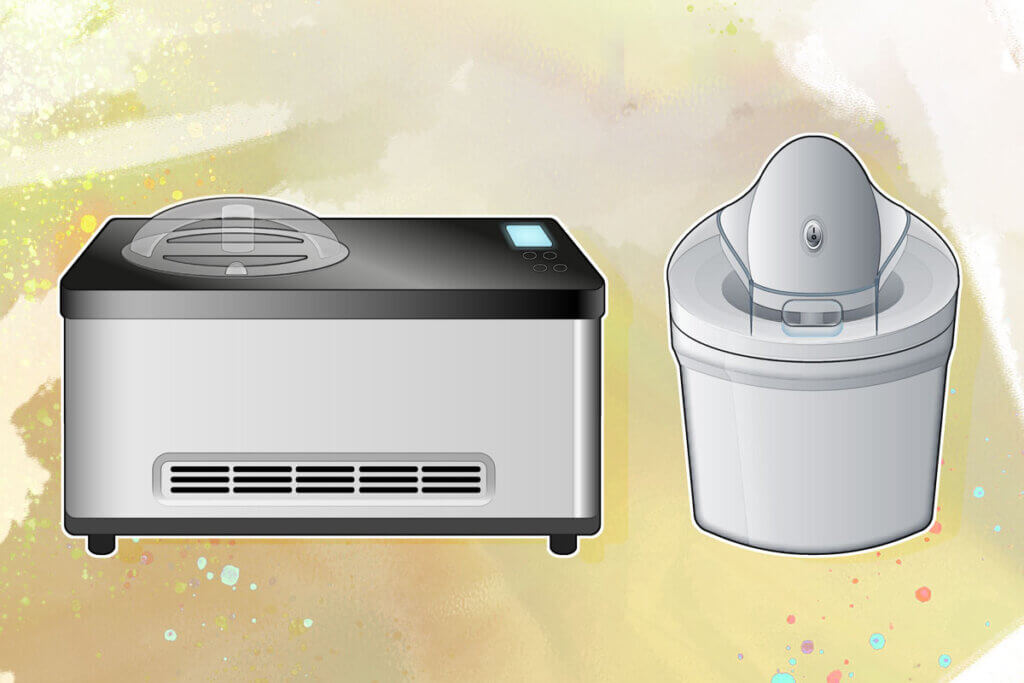
Compressorless
Compressorless ice cream machines usually have a removable cooling pack. They are cheaper than machines with a compressor – prices start at around $30. This saving does come at a cost though, they need to be pre-frozen for 8 to 24 hours before use. Spontaneity is not the name of the game here, you’ll need to have it cooled in advance of making any ice cream.
Aside from taking up space in your freezer, cooling packs are also quite unreliable. They heat up as you’re making the ice cream, so if they get too hot too quickly, you’ll end up with a failed batch. Once the cooling pack is warm, it will need to be chilled again. It isn’t all doom and gloom though, these ice cream machines are usually light and easy to carry. They are also much quieter and more energy-efficient than compressor machines.
Advantages
- Cheap
- Compact and light
- Quiet
- Low power consumption
Disadvantages
- Long pre-freezing time
- A lot of freezer space required
- Can fail if not cold enough
- Can only make one batch at a time
Who are these models best for?
Ice cream makers without a compressor are ideal for sporadic users. If you only want to make ice cream now and then, have a small budget, but a large freezer and a fair deal of patience, an ice cream maker without a compressor will suffice.
Tip
If you have enough space in your freezer, always keep the cooling pack in it so you can make ice cream whenever you want.
Compressor
Ice cream machines with a compressor start at around $50 and go up to around $200 for home models, but professional ones can cost well over $1000. They are self-cooling which means they don’t need to be put in the freezer beforehand. In fact, they work just like refrigerators which also have a compressor for heat removal. They cool down quickly and evenly to well below freezing whilst simultaneously stirring the ice cream mixture, creating creamy results. The best models take around 30 to 60 minutes to make a batch, and if you want, you can make another immediately afterwards – no need for pre-chilling.
One disadvantage you get with compressor ice cream makers is that they consume quite a lot of electricity. They are also quite large, heavy, and noisy. Weighing up to 33 pounds (15kg), they are comparable in size to a microwave oven and in loudness to a vacuum cleaner. While you don’t need to put any of their components in your freezer, they do take up quite a lot of space in your kitchen.
Advantages
- No pre-chilling
- Quick production
- Can be used multiple times consecutively
- Creamier results
Disadvantages
- Expensive
- High power consumption
- Large and bulky
- Noisy when in use
Who are these models best for?
Ice cream machines with a compressor are ideal for anyone who likes to experiment when making ice cream, has frequent guests, or who wants to splash the cash for the creamiest results.
Buying tips
The best ice cream machines are easy to use and produce high-quality ice cream. However, choosing a model is a bit more complicated than just these two criteria. Depending on whether you are a beginner or professional, occasional or frequent user, single or large family, you need to weigh up a lot of factors such as: capacity, performance and preparation time, build material, as well as the variety of functions and accessories.
Capacity
The capacity determines the amount of ice cream you can make in one run. The choice depends on how many portions you want to prepare at the same time. How much you need depends on whether you want to make ice cream mainly for yourself, for your family or also for guests:
- 16 ounce capacity: good for singles and couples
- 1 quart capacity: suitable for three to four people
- 1.5 to 2 quart capacity: ideal for large families or bigger dinner parties
Ice cream makers with compressors tend to have larger capacities, usually around twice as much as those without.
Maximum capacity versus maximum filling quantity
Bear in mind that the maximum capacity of the ingredients you put in the ice cream container is less than the actual capacity. This is because the amount of ice cream produced will end up being greater than the raw mixture. So, fill the mixing bowl no more than two-thirds full. For example, there is room for 1 quart of unchurned ice cream mix in the 1.6 quart freezer container of the Krups Perfect Mix 9000.
Motor power and noise level
The motor of an ice cream maker is responsible for both mixing and cooling. Its performance is therefore crucial for the quality of your ice cream. After all, you need a sufficiently powerful model to ensure that the mixture freezes evenly and that no crystals form. Inexpensive models with a passive cooling unit usually have a power output of 6 to 20 watts; high-quality ice cream makers with a compressor, on the other hand, have a power output of between 100 and 300 watts, which allows them to reach a temperature of -31 °F (-35 °C) in the shortest possible time.
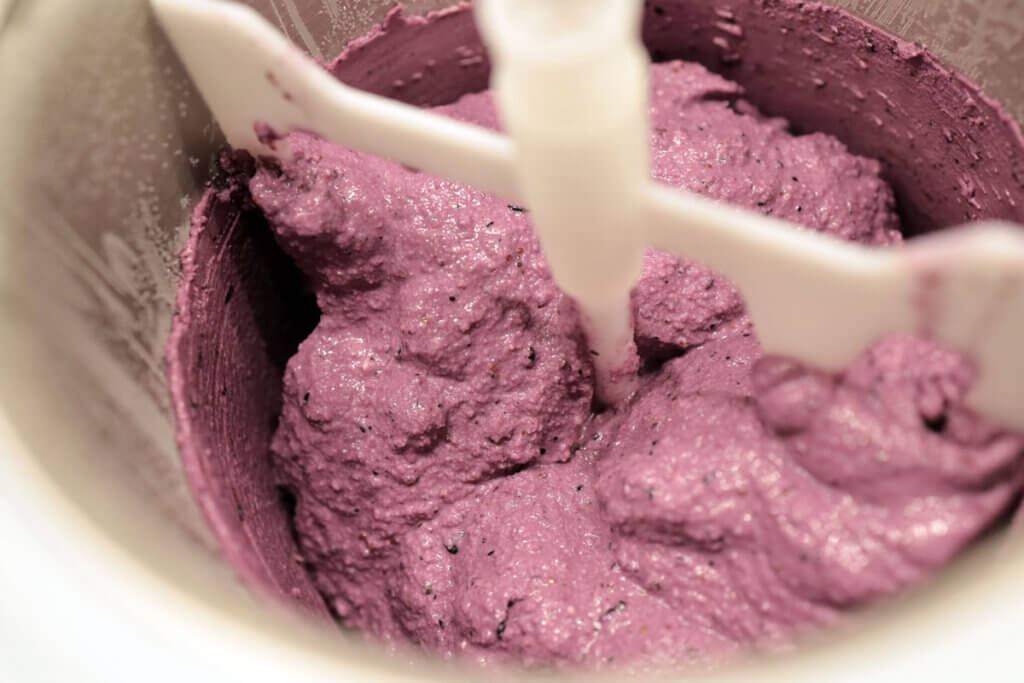
Noise output is directly related to power output. In other words, the more power, the louder the machine tends to be. Ice cream machines with compressors can produce up to 70 decibels – similar in noise level to a vacuum cleaner. Mid range compressor machines tend to produce between 60 and 65 decibels, while ‘quiet’ compressors are limited at around 55 decibels. Ice cream machines without compressors are significantly quieter than this – all you hear is the mixing blades rotate.
Production time
The cooling method doesn’t play a major role in how long it takes to produce ice cream. In fact, it all depends on the model, amount of ice cream being made, and the starting temperature of the ingredients. High-quality machines can take between 20 and 40 minutes to make ice cream, but its not uncommon for a machine to take between 90 and 120 minutes. If your machine needs to be pre-chilled beforehand, then remember that this can take between 8 and 24 hours.
Top-end machines have adjustable production times and timers so you can leave them completely unattended. Another thing to note is that smaller quantities of ice cream will be ready faster than larger ones. If your ice cream is finished but isn’t firm enough, just pop it in the freezer.
Build material
Ice cream makers tend to be made from either plastic or stainless steel (or a combination of both). It is common to find machines with plastic housings and stainless steel on the inside and for the stirrer. While plastic is light and easy to clean, stainless steel is extremely durable. Top-of-the-range models tend to have stainless steel housings, but you can also get great looking retro models made from plastic.
Lid and stand
Lids made from transparent plastic are great for letting you see inside whilst preventing and splashes. Some models have an opening so you can add things like chocolate chips during mixing. Rubberized non-slip feet are a great feature for making sure the machine stays in place.
Features
Having an easy-to-read screen on your ice cream machine is really helpful as it can show how long it has left to run as well as the temperature of the ice cream. Some models can automatically sense how long is left based on the temperature and consistency of the ice cream, and will make a noise when it is ready. This is an extremely useful feature – it makes things very easy!
If you want to make different kinds of ice cream like sorbet or frozen yogurt then make sure your machine has a wide freezing range. Frozen yogurt, for example, tends to be quite soft (and therefore warmer) than sorbet, which needs even lower temperatures than normal gelato.
Some models have a simple on/off button, but you can get ones with an automatic standby feature. This will turn the machine off once it is done making ice cream. A keep-cool feature does what it sounds like and can keep your ice cream cold for up to six hours – great for parties.
Accessories
Ice cream makers usually come with a lot of accessories like mixing jugs, scoops, and freezer containers. If you want to have a home ice cream parlor, consider getting things like:
- Ice cream cups and spoons
- Cream piping bag
- Ice cream wafers, sprinkles, and sauces
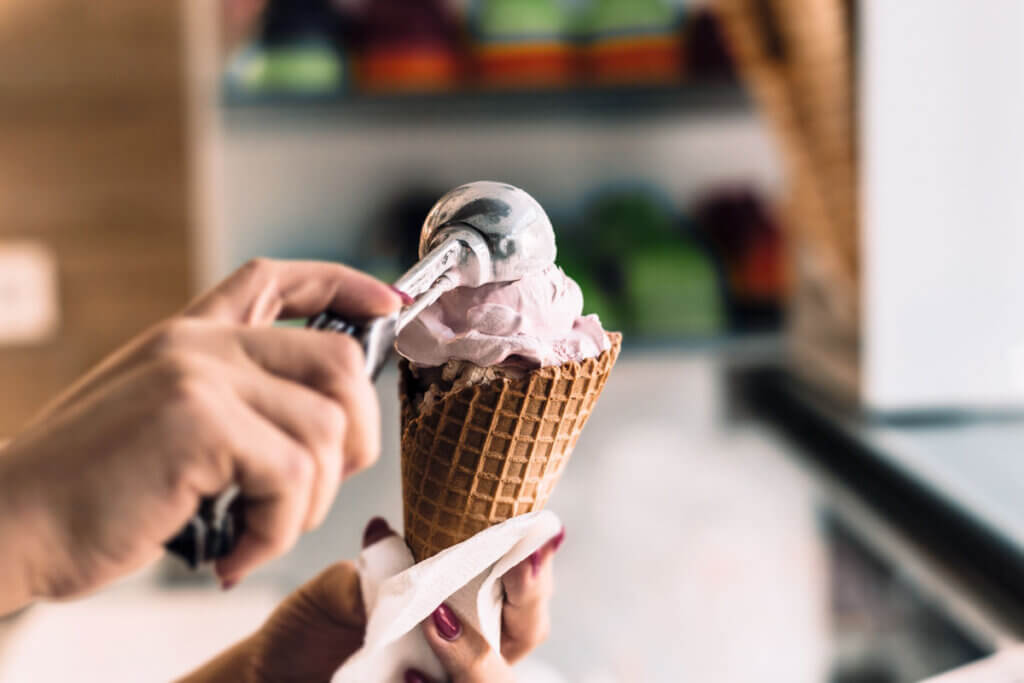
Types of ice cream
There are loads of different types of ice cream you can make with your machine. These include:
Sorbet
Sorbet is one of the oldest types of ice cream. It is made by stirring juice, syrup or frozen fruit quickly. You have to blend up the fruit in advance, as an ordinary ice cream machine is not capable of doing this. However, special sorbet machines do this automatically and even have a tap for portioning.
Parfait
To make parfait, you need to whisk egg yolks and sugar in a bain-marie, then add cream and any other flavors. The machine then processes the ingredients into a creamy mass.
Gelato
This Italian classic contains more milk, less cream and no eggs compared to traditional ice cream. Its consistency is denser and softer at the same time.
Frozen yogurt
Ice cream made from natural yoghurt scores with its low fat and sugar content. Depending on your taste, you can adapt the finished frozen yogurt with fruit, sugar or vanilla.
Soft serve
Soft serve ice cream is basically ice cream cooled down to 21 °F (-6 °C) instead of 10 °F (-12 °C). It is whipped to a creamy consistency with compressed air. For fans of this ice cream, you might want to consider getting a special soft ice cream machine. These have a tap so you can make the perfect soft serve cone.
Slush ice
These semi-frozen drinks consist of fruit juices, lemonades or coffee or tea, and often a mixture of syrup, flavorings, and colorings. They are therefore naturally dairy-free. Their bright colors make them a real eye-catcher. Slush ice machines crush the ice cream and mix it with the chosen flavoring to create a homogeneous mixture.
Classic ice cream
Traditional ice cream consists of milk, cream, sugar and egg yolks. If you prefer vegan ice cream, you can easily replace animal milk with plant-based alternatives such as soy, almond or coconut milk. Instead of egg yolk, use locust bean gum as a binding agent.
Recipe for delicious strawberry ice cream
For a classic strawberry ice cream, you need the following ingredients:
- Strawberries
- Sugar
- Cream
- Milk
- Eggs
- Lemon juice
- Vanilla extract
- Salt
Puree the strawberries as finely as possible, then mix the puree with the other ingredients – and off into the ice cream maker.
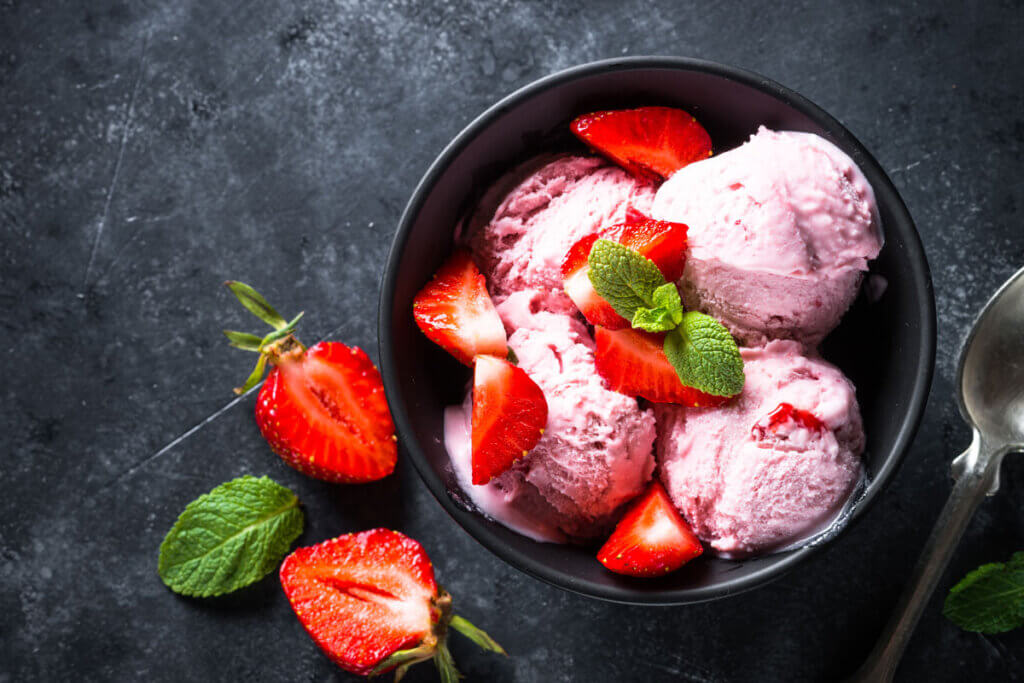
Shelf life and cleaning
The shelf life of your ice cream depends on the ingredients you use. Since you likely won’t be using preservatives, be aware that bacteria such as salmonella can survive in the freezer. Therefore, you should not store ice cream prepared with fresh eggs for more than three days. Also, do not refreeze it if it defrosts. If the ice cream is made of fresh fruit and milk, you should store it for a maximum of six days, as the fruit acid causes the milk to spoil quickly. It is also important for the taste and consistency that no ice crystals form. So, always pack the ice cream airtight and do not leave the ice cream container at room temperature for too long.
Most ingredients used to make ice cream provide an ideal breeding ground for health-threatening bacteria, germs, and mold. To always ensure perfect hygiene, it is essential to clean your ice maker carefully on a regular basis, ideally directly after each use. Cleaning is easiest if the appliance can be dismantled into individual parts and these are dishwasher-safe. This usually applies to all parts that come into contact with food, i.e. the lid, the mixing arm and the container. If these parts are not suitable for the dishwasher, you should at least be able to remove them easily to wash them under running water. However, never use an aggressive detergent, which could damage the components. Hot water and, if necessary, a mild detergent will suffice. Dry all components thoroughly before putting them back together.
Image 1: © FinalCheck | Image 2: © Charlotte.K-I. / stock.adobe.com | Image 3: © bnenin / stock.adobe.com | Image 4: © nadianb / stock.adobe.com

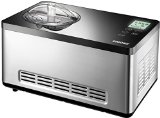
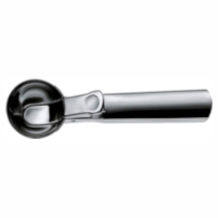
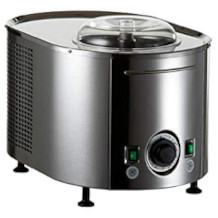










 2,598 reviews
2,598 reviews
